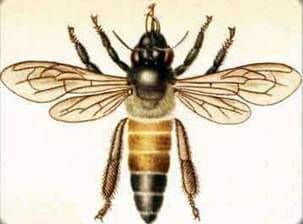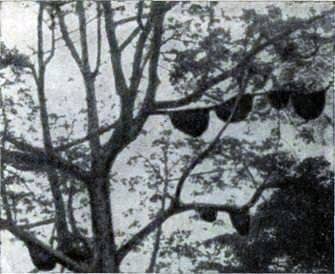
The giant bee surpasses even the hornet in size, and its bites are especially terrible. It is not surprising that a person does not take it to their apiaries. Buildings of this bee consist of one honeycomb, which can reach a meter in diameter, and bees build it in the air, under an overhanging rock, or on a branch of a weakly leafy tree. Even more prone to flying than Indian bees, they often migrate over long distances. But, wherever they build their new honeycomb, they make it so that the sky can be seen from it.

Fig. 116. “Bee tree” in the botanical garden in Ceylon. The family of Indian giant bees builds their large, freely hanging honeycomb under the open sky on branches of poorly leafy trees.
So we got to the question that interests us the most: these bees dance in the same way as ours. They tell their friends the direction and distance to the source of the bribe with the rhythm of the dance and its wagging run. Like honey bees, they transpose the angle to the sun in relation to the sun with respect to gravity on the vertical surface of the honeycomb, but they succeed only if they see the sun or the blue sky when they dance.
This is one of the main reasons that they build honeycomb under the open sky. To notice the angle between the direction to the source of the bribe and the direction to the sun and then in the darkness of its buildings from memory to translate it into an angle between the direction of the wobbling run and the direction of gravity – this they are not yet able to do. And in this respect the way of their mutual understanding is somewhat more primitive.
Even more ancient and therefore the most interesting species is a dwarf bee. This is an adorable dwarf: less than a room fly, with a brick-red belly and a silvery-white pubescence.
Рамка с натянутыми. Медовик на сметане рецепт с.
Breeds of bees